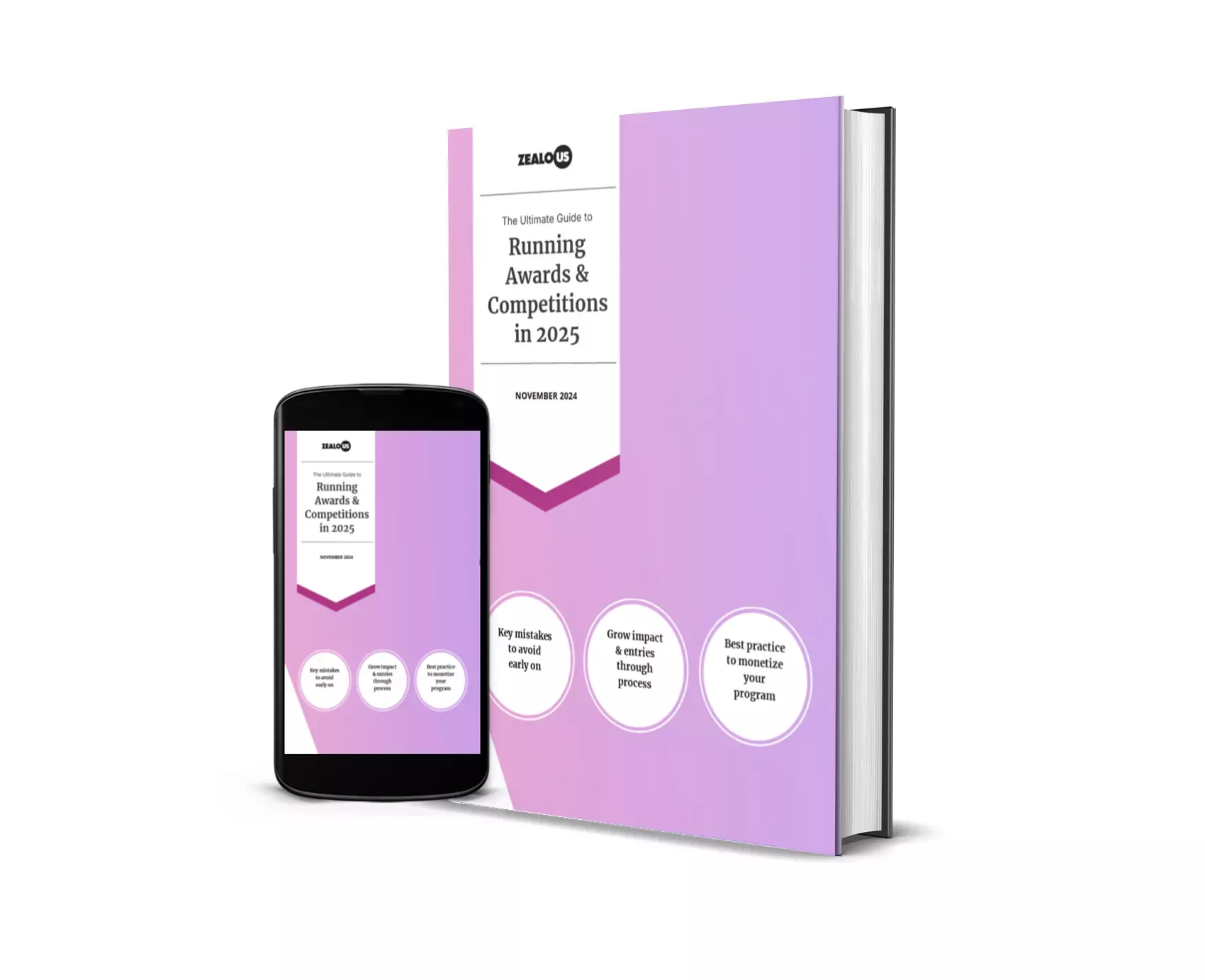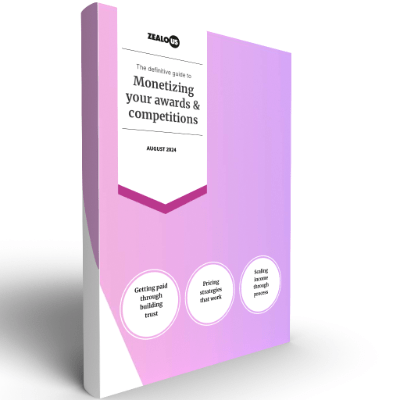This article covers:
- Why category structure determines programme success
- Researching categories your audience wants
- The Goldilocks problem (not too few, not too many)
- Clarity through naming conventions
- Eligibility criteria to prevent arguments
- Category pricing strategies
- Common structural mistakes that kill programmes
- When to split versus combine categories
- Growing categories as programmes mature
- Testing structure before launch
Your awards programme has a brilliant purpose. Solid budget. Enthusiastic stakeholders. Then you sit down to write the categories and… well you blank.
How many categories? Too few and you exclude talent. Too many and nobody knows where they fit. Name them wrong and excellent work ends up in the wrong place (or worse, the best candidate bounce).
Category structure isn’t admin work. It shapes who applies, how judges work, what marketing messages resonate. Get it right and categories become your programme’s skeleton: everything else builds around them naturally.
Category Structure Shapes Everything
Don’t treat categories as an afterthought, they are the backbone of many of the processes that follow!
Your category structure determines your entire programme architecture. Marketing messages change based on categories. Judge recruitment depends on expertise needed. Submission forms differ by category requirements. Entry fees might vary. Even your awards ceremony flow follows category logic.
Categories also signal what you value. A photography competition with 15 landscape categories and one portrait category sends a clear message about priorities. Whether intentional or not, applicants will notice it.
When categories go wrong, they go really wrong. Overlapping categories confuse applicants (“Do I submit here or there?”). Categories too broad make judging impossible (comparing sculpture to performance art?). Categories too narrow get three entries each. Poorly named categories attract the wrong submissions.
Each structural flaw compounds. Confused applicants submit to wrong categories (more work sorting them). Judges struggle comparing apples to oranges (lower quality decisions). Winners feel their category lacked prestige (reputation damage). Next year, fewer people apply.
Your category structure deserves serious planning time.
Start With Research, Not Assumptions
You think you know what categories your audience wants. Maybe you do. But verify first.
If you already have a community (past participants, newsletter subscribers, social media followers), survey them. “What categories would make you more likely to enter?” generates valuable insights. But don’t just accept surface answers. If someone suggests “Best Innovation,” dig deeper. Innovation in what context? Which aspects of innovation matter most?
Look at where your target audience already wins recognition. Visit their websites, check their social media. Companies love displaying awards. Individual creatives showcase recognition in portfolios. This research reveals which categories hold actual value for them.
Competitive research matters enormously. Related awards in adjacent industries reveal opportunities for differentiation.
What to document from research
- Categories competitors offer
- Categories with high entry volumes
- Categories that seem outdated
- Emerging areas nobody addresses yet
- Gaps where excellent work goes unrecognised.
This research typically reveals patterns you’ll notice certain categories appear everywhere (those are expectations). You’ll spot categories only one competitor offers (potential differentiation). You’ll identify areas nobody serves (genuine opportunities).
The Grammy Awards restructured significantly in 2012, collapsing 109 categories into 78 based on years of data about which categories received strong submissions versus which ones languished. They’ve continued refining, adding Best American Roots Song in 2014 when they realised songwriter recognition mattered differently than recording recognition (they also finally stopped differentiating genders and merged best male and female signers in the same categories).
Industry trends inform category decisions too. AI emerged as a category across business awards only in the last two years. Sustainability categories proliferated in the 2010s. If your programme ignores emerging trends, you might miss opportunities to lead conversations.
Download launch checklist
Never miss a critical step: 300+ tasks across 8 phases, from securing judges to winner announcement.
The Goldilocks Problem (Finding “Just Right”)
Three categories leaves too much excellent work unrecognised. Fifty categories overwhelms everyone.
Small programmes (under 200 expected entries) typically need 5-12 categories. This provides meaningful recognition diversity without spreading entries too thin. If you’re expecting 100 submissions across 5 categories, that’s 20 entries per category on average: (just about) enough for competitive judging.
Medium programmes (200-1,000 entries) often need 12-25 categories. You’re serving a broader audience, probably multiple sectors or demographics. More categories prevent the “I don’t fit anywhere” problem that costs you submissions.
Large established programmes (1,000+ entries) might support 25-50 categories or more. The Best in Biz Awards offers over 100 categories across five focus areas because they serve the entire business community globally. That huge scope requires granularity.
Start smaller than you think you need. Adding categories next year excites people. Removing categories next year without reason…not so much.
For first-year programmes, aim for 5-8 strong categories. Prove the concept works. Gather data on what resonates. Expand thoughtfully in year two.
One technique works beautifully: hierarchical structure. Instead of 30 flat categories, create 6 main categories with 3-5 subcategories each. This maintains clarity whilst providing specificity.
Example: “Company of the Year” splits into size brackets (Small, Medium, Large) then industry sectors (Technology, Healthcare, Professional Services, Manufacturing, All Other Industries). Six options become 15+ without feeling overwhelming.
Modern platforms should handle enhanced category structures with grouping and subgrouping capabilities. If your platform limits you to flat category lists, that’s a red flag about scalability.
Naming Conventions Matter More Than You Think
“Excellence Award” tells applicants nothing. “Excellence in Sustainable Architecture for Educational Buildings Under 5,000 Square Metres” tells them everything but nobody reads that far.
Category names need clarity above all else. Someone should read the name and immediately know if they might fit. That doesn’t mean boring, it means descriptive.
Good category names: “Emerging Designer (Max 3 Years Pro Experience).” “Best Mobile App: Healthcare Sector.” “Innovation > Manufacturing Processes.”
Bad category names: “The Innovator’s Trophy.” “Rising Star Excellence.” “Outstanding Achievement.” (yay, you’re the best…but at what?).
The second group sounds impressive but means nothing specific. Who qualifies? What work fits? Nobody knows without reading lengthy descriptions and many people won’t bother.
Keep category names under 60 characters when possible. That’s not arbitrary: it’s about how they display across your website, application forms, marketing materials, and awards ceremony slides. Long names get truncated or wrap badly.
Use parallel structure across categories. If one category starts with “Best,” others should too. If you use active verbs (“Transforming Healthcare Through Technology”), be consistent. Mixed conventions look unprofessional and confuse applicants about category relationships.
Don’t force uniqueness at the expense of clarity. Your category names don’t need to be clever. They need to work.
Define Eligibility Clearly
Vague eligibility creates three problems: wrong submissions (wasted judge time sorting them), arguments about judging decisions (participants claiming unfair treatment), and potential reputation damage (word spreads that your programme isn’t professional).
Each category needs explicit eligibility criteria visible both in category descriptions and during the submission process. These criteria typically cover:
- Geographic scope: “Open to UK-based organisations only.” “Global competition, all countries welcome.” “Must operate primarily in Southeast Asia.”
- Organisation type: “For-profit companies only.” “Charitable organisations and social enterprises.” “Individual practitioners, not companies.”
- Type of work/medium: “Painting”, “Oil Painting”, “Photography, “B/W Photography”…
- Experience level: “Emerging professionals with fewer than 5 years in industry.” “Established artists with prior exhibition history.” “Students currently enrolled in accredited programmes.”
- Work requirements: “Project must have completed between January-December 2024.” “Product must be commercially available.” “Work must be original and unpublished.”
- Size constraints: “Annual revenue under £5 million.” “Teams of 2-10 people.” “Projects with budgets between £10,000-£100,000.”
The stricter your criteria, the fewer arguments later. But strict criteria also reduce your applicant pool. Balance carefully.
Here’s an example of clear eligibility criteria: “Eligible entries must be new technology products, applications, or features developed within the last three years and commercially available at the time of submission.”
Clear timeframe (3 years). Clear product types (technology products, apps, features). Clear status requirement (commercially available). Someone reading this knows immediately if they qualify.
This translates to creative works equally well – works created since the 1st of January 2025, by artists who have been selling their work for the last 3 years and are not represented by a gallery.
You need to think carefully about edge cases too. What if someone’s work spans two categories? Can they submit to both? (Usually yes, with separate fees.) What if someone’s organisation size changed mid-project, and artist becomes represented…? (Decide based on size at project completion.) What if the work was collaborative? (Define how credit works.)
If applicants can submit the same entry to multiple categories, state that explicitly. Some programmes encourage it (more revenue, broader recognition). Others discourage it (keeps categories distinct). Neither approach is wrong, but ambiguity creates problems for you.
Want more articles like this?
Give this one a like
Category Pricing Strategies (Beyond Flat Fees)
Most programmes charge the same entry fee across all categories. Simple, fair, easy to communicate.
But consider alternatives: Tiered pricing by organisation size encourages broad participation. Small organisations might pay £50 whilst large corporations pay £200 for identical categories. This increases accessibility without reducing revenue significantly: you get more small organisation entries at lower prices.
Early career pricing works similarly. Emerging professionals pay less than established ones. Students pay even less or enter free. Yes, you’re leaving money on the table per entry, but you’re growing your programme’s reach and reputation.
Premium categories exist too. Some programmes charge more for high-visibility categories (like “Overall Winner” or “Company of the Year”) because winning these carries extra prestige. The price signals category importance whilst generating revenue for other programme costs.
Volume discounts make sense for programmes encouraging multiple submissions. First entry full price, second entry 20% off, third 30% off. This particularly benefits organisations that could fit multiple categories: you want those entries.
The key question: does differential pricing serve your programme goals or create confusion? If your mission prioritises accessibility, tiered pricing helps. If simplicity matters most, flat pricing works.
Common Structural Mistakes (Learn From Others’ Pain)
Mistake 1: Categories that overlap confusingly
“Best Digital Marketing Campaign” and “Most Innovative Social Media Strategy” sound different but probably attract identical submissions. Judges end up comparing the same work twice. Applicants agonise over which category fits better. Fix this by clearly distinguishing categories or combining them.
Mistake 2: Categories too broad for fair judging
“Best Creative Work” could mean anything from poetry to sculpture to dance to graphic design. How do judges compare these meaningfully? They can’t. Either split into medium-specific categories or accept that judging becomes purely subjective (which undermines programme credibility).
Mistake 3: Categories too narrow with insufficient entries
Creating “Best Watercolour Landscape Painting by Artists Under 30 in the Outer Hebrides” might get three entries (if you’re lucky). Ultra-specific categories feel professional until nobody enters them. The programme looks unsuccessful, judges waste time on tiny categories, winners feel their award lacks prestige (If your the winner in a room of one…that’s telling).
Mistake 4: Trendy categories that age badly
Creating categories around emerging trends makes sense but be ready to evolve them quickly as spaces mature (you may wish to rethink your Salt Bea look alike category!).
Mistake 5: Categories that assume too much knowledge
Categories that assume too much knowledge. Industry-specific programmes often create categories using jargon that even industry insiders struggle to decode (if you’re dealing in the AI space…this is for you).
Mistake 6: No path for genre-defying work
No path for genre-defying work. Without an “Other” or “Cross-Disciplinary” category, otherwise excellent work that defies traditional categories goes unrecognised (and you lose the opportunity to be the first to celebrate it).
When To Split Versus Combine Categories
Split categories when: Entries for a broad category exceed 200 and contain clearly distinct subcategories. Combining very different work types makes judging impossible. You want to recognise excellence across multiple dimensions (geography, size, approach). Market feedback shows people want more specific recognition. Next year’s programme needs growth and category expansion signals momentum.
Combine categories when: Individual categories receive fewer than 10 entries consistently. Categories overlap so much that judges debate placement constantly. Your programme struggles to recruit enough qualified judges for narrow categories. Marketing messages become too complex explaining dozens of subtle distinctions. Research shows participants don’t value the specific distinction.
Smart category splitting example
Start with venue types (congress centres, conference venues, exhibition halls). Each type splits by size (small, medium, large). Some venues split further by purpose (sports, concerts, corporate events). This creates many pathways without overwhelming people at first glance: they follow a logical decision tree.
Test splits in year two or three, not year one. Gather data on entry distribution first. If “Best Product Design” gets 200 entries split roughly equally between consumer products (105) and industrial products (95), splitting makes sense. If it’s 180 consumer and 20 industrial, don’t split them – splitting creates one strong category and one weak one.
Platforms supporting multi-category submissions reduce the risk of splitting. If someone can easily enter multiple relevant categories, category proliferation matters less. Without that capability, each additional category adds friction.
Growing Categories as Programmes Mature
Year one: 5-8 core categories max. Prove the concept. Gather data. Understand your audience.
Year two: Analyse entry distribution. Which categories overflowed? Which languished? Add 2-4 categories addressing gaps. Consider splitting high-volume categories if they contained distinct work types. Take into consideration how judging went on the first year, and if a split would have made the decision making easier.
Year three: Your programme has momentum. Expand strategically to 12-18 categories. Introduce emerging areas. Test experimental categories with lower visibility: if they work, promote them year four.
Year five onwards: Established programmes can support 20-30+ categories depending on entry volume. But continued refinement matters. The Grammys continually adjust categories after 65+ years because music evolves. Your programme should too.
Be mindful when you reach the 20-30+ categories – we’ve all seen business prizes where you can see categories solely exist to make money. Too many categories is one of those warning flags. If you were to get to that number consider splitting your prize. Seeding new prizes with their own judges and prize money. If you have hundreds of judges across hundreds of categories none of them will feel special.
Categories consistently underperforming? Merge them, rename them, or retire them. Nobody wins when categories exist just because they always have.
Track these metrics per category: Number of entries received. Entry quality (judge scores). Winner visibility and impact. Subsequent year retention (winners and runners-up returning). Judge satisfaction with category scope and quality.
New categories need marketing investment. Don’t just add them quietly. Announce “Introducing Our Newest Category” with explanation of why it matters. Otherwise, people won’t know to apply.
Insights like these straight to your inbox
Receive weekly tips from our founder to grow your program’s impact; regardless of what tools you use.
Testing Structure Before Launch
Category structure on paper differs from how it works in practice. Test thoroughly before opening submissions.
Testing checklist
- Do any category names confuse your team? (If your team is confused, applicants definitely will be.)
- Can you write clear, distinct 2-3 sentence descriptions for each category without overlapping?
- Would someone from your target audience immediately understand where their work fits?
- Could judges specialising in each category evaluate entries fairly without constant cross-category comparisons?
- Does the structure support your overall programme goals?
Show your category structure to 5-10 people from your target audience. Not for formal approval: for understanding their reaction. Watch their faces when they read category names. Confusion means problems. Ask them to describe which category their work would fit. If they struggle, rewrite.
Test the submission process too. Modern platforms should preview forms exactly as applicants see them. Walk through category selection as if you’re applying. Are options clear? Do descriptions appear at the right moment? Does anything feel clunky?
Pay special attention to category-specific form fields. If someone selects “Student Category,” do relevant questions appear asking for student status proof? If they choose “Corporate Category,” do organisation size questions trigger? This dynamic form functionality prevents submissions to wrong categories.
Finally, test from mobile devices. Many applicants explore programmes on phones before committing to desktop submission. If your category structure looks fine on desktop but becomes incomprehensible on mobile, you’ll lose entries.
Finally
Category structure isn’t glamorous work. It doesn’t make awards ceremonies exciting or winners’ Instagram posts go viral.
But it’s foundational. Everything else (marketing messages, judge recruitment, submission forms, evaluation processes, winner announcements) builds on category decisions. Poor structure undermines every other aspect of your programme.
Take the time. Do the research. Test thoroughly. Adjust based on what you learn. Your categories will evolve as your programme grows, and that’s good. Rigid category structures break when audiences shift. Flexible structures adapt.
Start with 5-8 strong categories that clearly serve your audience. Expand thoughtfully based on data. Keep names clear and eligibility explicit. Test everything before launch. Track what works.
Your programme deserves a category structure that makes excellence visible, judging fair, and recognition meaningful. Build that structure intentionally, not accidentally.
We can help!
Zealous streamlines entries (& categories)
But we’re not alone in the space – here are 8 others you may wish to consider (even if we would prefer you choose us!).
Want us to write more content like this? Give it a like
Share

Guy Armitage is the founder of Zealous and author of “Everyone is Creative“. He is on a mission to amplify the world’s creative potential.
Frequently Asked Questions
How many categories should I create for my first awards programme?
For first-year programmes, aim for 5-8 categories. This provides meaningful diversity without spreading entries too thin or overwhelming judges and applicants. If you’re expecting 100-200 submissions, 8 categories means roughly 12-25 entries per category: enough for competitive judging. Starting smaller lets you prove the concept works and gather data on what resonates with your audience.
You can always expand in year two based on entry distribution and feedback, but removing underperforming categories signals failure. Better to grow gradually than to launch with 20 categories and see half of them receive only 3-5 entries each.
Should all my categories have the same entry fee?
Flat pricing across all categories is simplest and easiest to communicate. However, consider alternatives if they serve your programme goals. Tiered pricing by organisation size (small businesses pay £50, large corporations pay £200) increases accessibility whilst maintaining revenue. Early career or student pricing expands your reach and reputation. Premium pricing for high-visibility categories like “Overall Winner” signals importance whilst generating revenue.
Volume discounts (second entry 20% off) encourage multiple submissions from organisations that fit several categories. Whatever approach you choose, make the logic transparent in your pricing information.
What if someone’s entry fits multiple categories?
Decide your policy and state it explicitly in your guidelines. Most programmes handle this one of two ways: Allow multiple submissions with separate fees for each category (this increases revenue and recognition opportunities), or require applicants to choose one category but allow you to reassign entries to more appropriate categories during review. The first approach is more common and transparent.
Make sure your submission platform supports multi-category submissions where applicants can apply to several categories efficiently without starting from scratch each time.
How do I know if my categories are too broad or too narrow?
Track entry distribution after your first year. Categories receiving 50+ entries might be too broad if they contain very different work types that judges struggle to compare fairly. Categories receiving fewer than 10 entries consistently are probably too narrow: either expand eligibility or combine with related categories.
The sweet spot depends on your total submission volume. For programmes with 500+ entries, categories of 20-40 entries work well. Smaller programmes might aim for 10-25 entries per category. Watch judge feedback too: if judges complain about comparing apples to oranges, your categories are probably too broad.
When should I split an existing category into multiple categories?
Consider splitting when: An existing category consistently receives 100+ entries, those entries contain clearly distinct subcategories (different industries, organisation sizes, or approaches), judges report difficulty comparing very different entry types, and market feedback shows people want more specific recognition.
Test splits carefully. If “Best Product Design” gets 180 consumer product entries and 20 industrial product entries, splitting creates one strong category and one weak one. Better to maintain the broad category or wait until distribution becomes more balanced. Split when both resulting categories would have healthy entry volumes (20+ each).
How do I prevent applicants from submitting to the wrong category?
Write clear, specific eligibility criteria visible in both category descriptions and during submission. Include concrete examples of work that fits versus doesn’t fit. Use category-specific eligibility questions in your submission form: if someone selects “Student Category” but can’t provide student ID proof, the form shouldn’t let them proceed.
Modern platforms should support dynamic form fields based on category selection, preventing ineligible submissions before they happen rather than sorting them manually later. When edge cases arise, provide a contact method for applicants to ask questions before submitting: better to clarify upfront than to reassign entries afterward.
Can I change my category structure after launching my programme?
Minor clarifications to category descriptions are fine mid-programme. Significant changes like adding categories, removing categories, or altering eligibility criteria should wait until the next edition. Changing structure mid-programme frustrates applicants who already submitted, confuses those considering applying, and complicates judging.
The exception: if a category receives zero entries, you can quietly retire it and reallocate any submitted entries to more appropriate categories, but communicate directly with affected applicants. For future editions, analyse entry distribution and feedback to identify needed changes, then implement them before opening the next submission period.









